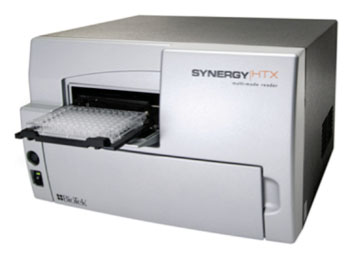Modular Design of New Microplate Reader Encourages Modification and Upgrades
By LabMedica International staff writers
Posted on 26 Aug 2014
Life science and biotech researchers now have available a state-of-the-art modular microplate reader with a wide range of capabilities from UV-visual absorbance to bottom fluorescence and luminescence.Posted on 26 Aug 2014
The new BioTek Instruments, Inc. (Winooski, VT, USA) Synergy HTX Multi-Mode Microplate Reader is an entry-level multimode reader that automates UV-visual absorbance, fluorescence, luminescence, and AlphaScreen/AlphaLISA assays in 6- to 384-well microplates that can be delivered in samples as small as two microliters.

Image: The Synergy HTX Multi-Mode Microplate Reader (Photo courtesy of BioTek Instruments, Inc.).
AlphaScreen (Amplified Luminescent Proximity Homogeneous Assay Screen) is versatile assay technology developed to measuring analytes using a homogenous protocol. This technology is an example of a bead-based proximity assay and was developed from a diagnostic assay technology known as LOCI (Luminescent Oxygen Channeling Assay) where singlet oxygen molecules, generated by high energy irradiation of donor beads, travel over a constrained distance of approximately 200 nanometers) to acceptor beads. This results in excitation of a cascading series of chemical reactions, ultimately causing generation of a chemiluminescent signal. Recently, the basic AlphaScreen technology was extended in that the chemistry of the acceptor bead was modified such that emitted light is more intense and spectrally defined, thereby markedly reducing interference from biological fluid matrices (such as trace hemolysis in serum and plasma). In this format, referred to as AlphaLISA, it provides an alternative technology to classical ELISA assays and is suitable for high throughput automated fluid dispensing and detection systems.
The Synergy HTX incorporates linear and orbital shaking and Four-Zone incubation to 50 degrees Celsius with condensation control to minimize plate lid condensation. These features, coupled with an available dual reagent dispenser, make the Synergy HTX an excellent platform for biochemical and cell-based applications such as nucleic acid quantification, cell growth and toxicity assays, kinetic ELISA, and inject/read assays.
The optional dual reagent injection system automates inject/read assays such as ion channels assays or flash luminescence assays (e.g., luciferase or ATP assays). The Synergy HTX’s modular design allows upgrading supported by BioTek’s Gen5 data analysis software for advanced reader control, data analysis, graphing, exporting, and reporting. Additionally, the instrument is compatible with BioTek’s Take3 Multi-Volume Microplate that measures up to 16 two microliter samples, two BioCells, or a standard cuvette for fast and simple multivolume, multisample analysis.
Related Links:
BioTek Instruments, Inc.













